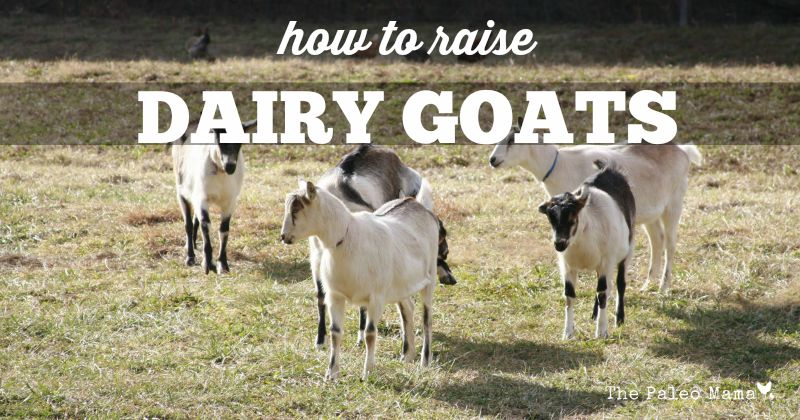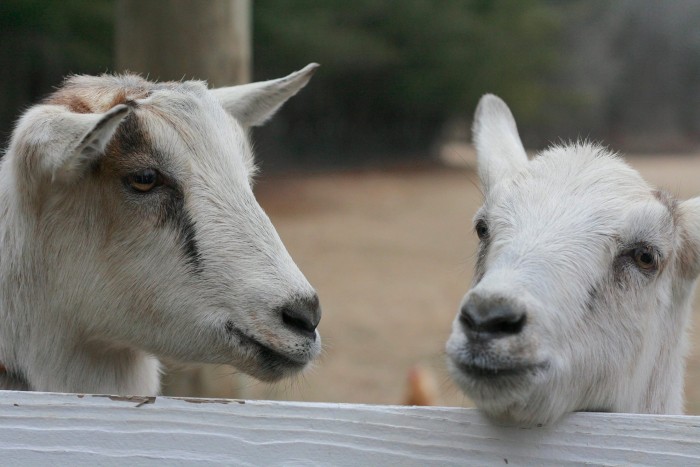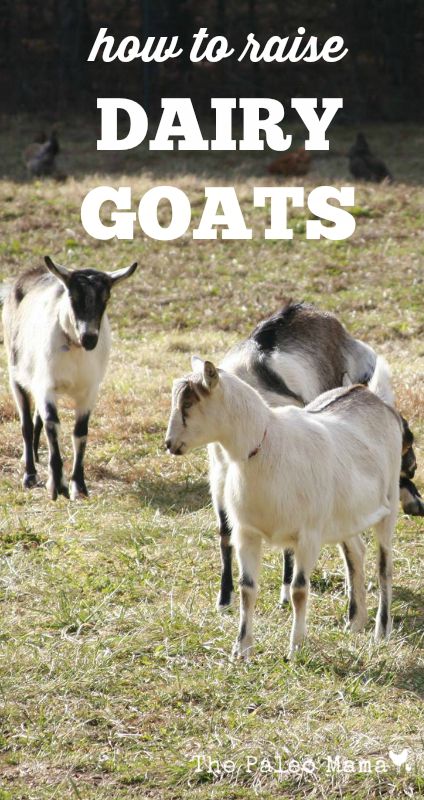
If you have followed me for awhile, you already know that my entire family has fallen in love with goats! We’ve been raising dairy goats for a couple years now and I’m excited to share with you how to raise dairy goats. I guarantee you will enjoy them!
Regardless of whether your property is one acre (we got our first goats when we lived on 3 rented acres) or hundreds, sloping or flat, completely forested or filled with green pasture land, you can still raise dairy goats for milk. If you have just 2 dairy goats, which will give you an average of 1-2 gallons of milk a day for 10 months, it will keep your family in wonderful raw dairy goat milk all year. You will, also, have milk for making cheese, yogurt, and even ice cream.
Goats are hardy and adapt well to changing climates. They forage and graze, require little space, and are reasonably inexpensive to keep. But best of all, they are highly intelligent and very friendly. Because they are extremely curious and agile, their antics can keep you laughing for hours. We believe our goats are the perfect addition to our homestead.
Why raw milk?
Finding delicious raw milk is not an easy thing to do in most states, which is why I decided to just raise my own goats for raw milk. Raw milk, from pastured cows, goats, and sheep, contains all the fat and has not been processed in any way. Real Milk tells us that pasteurization destroys enzymes, diminishes vitamin content, denatures fragile milk proteins, destroys vitamins C, B12 and B6, kills beneficial bacteria, promotes pathogens and is associated with allergies, increased tooth decay, colic in infants, growth problems in children, osteoporosis, arthritis, heart disease and cancer (source).
If you can’t raise your own goats or cows for raw milk, then you can check HERE to see if there is a recommended farmer near you.
I want to introduce you to the responsibilities and pleasures of raising dairy goats in this blog. We will consider these six aspects of raising dairy goats:
- What kind of goats should I consider for my dairy goat adventure?
- What kind of shelter and fencing do I need for my goats?
- What should I feed my goats?
- What do I need to know about my dairy goats’ milk production?
- What health considerations do I need to be sure I’m providing to my goats?
- What are a few sample things I can do with the raw goat milk my goats give me?
1. What kind of goats should I consider for my dairy goat adventure?
There are more than 200 different goat breeds worldwide; seven primary breeds dominate the dairy goat arena:
- Alpines—originated in the Swiss Alps, and has a long neck and two-toned coat. The Alpine averages the highest milk output of any breed
- Oberhaslis—native to Switzerland, and relatively rare in North America. It has a gentle disposition and a reddish brown coat with black markings.
- Saanens—this is the most popular breed worldwide, and is a big goat with a very mild temperament and a white or cream-colored coat.
- Toggenburgs—this is a friendly, gentle goat with white ears, white face stips, and white stockings and a brown coat.
- LaManchas—the La Mancha is considered the calmest and friendliest of the dairy breed, and comes in just about any color a goat can be.
- Nigerian Dwarfs—this miniature dairy breed produces less milk, but is ideal for a small family with a small backyard. Its teats are smaller so milking may be difficult for someone with large hands. It comes in all goat colors.
- Nubians—the Nubian is popular among makers of cheese and ice cream because its milk is richer than that of other full-size goats. It comes in many colors, and is the most energetic and vociferous of the dairy breeds. You can easily distinguish it by its rounded face and long floppy ears.
We have a mixed herd of Alpines and Nubians. The Alpines give a ton of milk, which is why we chose that breed. Our Nubians are probably the most adorable goats I have ever seen. We love their personality and their milk definitely is higher in butterfat, making it a great resource for cheesemaking.
It is SUPER important that you purchase your dairy goats from a reputable dairy goat breeder and that you ensure that you start with healthy stock that has been tested for CAE with proven genetics. We purchased ours from Ziggy at Sunrise Farm in North Carolina and made sure they were registered with the American Dairy Goat Association. Yes, we spent a little bit more than what we would have for a dairy goat on Craigslist or the stock yard, but I KNOW that my goat comes from good stock and is healthy. We, also, used Sunrise Farm’s proven buck to breed our girls last fall.

2. What kind of shelter and fencing do I need?
Your dairy goats will need some kind of shelter. It doesn’t have to be fancy, but it does have to be clean, dry, and draft-free, yet well ventilated. It can be anything from an old outbuilding to a small shed or barn. Experts recommend at least 15 square feet of housing per goat. Stalls should be equipped with a rack for hay, a trough or box for grain, and a water pail holder. Include extra space for storing feed and other supplies, as well as a stand for milking. (See my blog on a homemade milking stand here.) Keep the goats’ bedding clean and dry. Remember that goat manure and bedding are great for the garden.
They will need plenty of outside space to play, exercise, and forage to their hearts’ content. Some experts suggest 200 square feet as a minimum, but more is even better. Remember that goats with room to roam come with a price: good, sturdy fencing. They can squeeze through openings, nudge their way through weak areas, and hop a fence. Keep your woven wire or high-tensile electric fence at least 4 feet high. We have used galvanized fencing wire that is about 4 feet high with no electric fence and it worked perfect. In our new house, the previous owners had a smaller breed of goats and the fencing wasn’t 4 feet tall. Our large dairy goats have been able to jump right over it and make their way over to my beautiful garden for a snack.
We’ve solved that problem by adding a line of electric fence over the top of the galvanized fence. They do NOT like getting shocked by the fence now and avoid it like the plague!
3. What should I feed my goats?
It’s really best to let your goats forage in the pasture for 90-100% of their food intake. They are opportunistic feeders, and will eat whatever they find. Be aware that some plants, such as oleander and wild onions are poisonous to goats. You can find a comprehensive list of plants to keep out of their pasture area here.
If you don’t have pasture and forage available, then you will need to supply quality hay for them at all times. You can do this by putting the pellets in feeders free choice.
In addition to pasture and forage, a milking doe can receive some extra grain every day to supply extra protein (12-16%) and give their milk supply a small boost. Grain is only given to our milking does when we are milking them. They get about 1 cup of our homemade grain for each quart of milk they are giving us. We have always left the kid/kids with the milking doe too, so if they are feeding their baby and giving us milk, we remember to give them a little bit more than 1 cup of grain per quart of milk we are getting. We also add a scoop of alfalfa pellets or Chaffhaye to the feeder when we are milking them.
Provide fresh water at all times.
Our homemade feed recipe for milking does (12% protein before adding Chaffhaye or alfalfa pellets):
- 3 parts whole organic barley
- 3 parts whole organic oats
- 1 part black oil sunflower seeds.
- *We add a scoop Chaffhaye or alfalfa hay to each feeder when the doe is on the milk stand providing even more nutrition and protein.
We purchase these through Azure Standard and it’s the easiest and cheapest organic goat feed I have ever used. Plus, my goats love it! Also, only our goats in milk receive feed. If they are not in milk, they forage and eat alfalfa hay in the winter.
We make sure our goats have a red mineral block and a white salt block (with selenium) to supply the extra nutrients that they need.
When you are making the decision to begin raising dairy goats, you will want to consider the costs involved for you. It will be important for you to determine your own costs and budget, but I am inserting the following Cost Table to give you some idea of the costs you will incur.
| Table 1. Hobby Enterprise: 10 milking dairy goats per year. Average 2050 lb milk per lactation. | ||
| Cost Per Doe | % of Total | |
| 1825 lb hay @ 200/T (5 lb daily) | $182.50 | 18 |
| 1025 lb grain mix @ $0.21/lb (3.3 lb average during lactation, 1 lb while dry) |
$227.85 | 22 |
| Bedding (straw – 100 bales @ $2.50 bale) | $250.00 | 3 |
| Breeding (cost of keeping a buck) | $41.78 | 4 |
| Vet costs | $50.00 | 5 |
| Operating expense (supplies, utilities, maintenance) | $150.00 | 15 |
| 69.4 hours of labor @ $5/hr | $347.00 | 33 |
| Total | $1024.13 | 100 |
| Cost of producing 100 lb milk | $49.96 | |
| Cost per gallon | $4.30 | |
4. What do I need to know about my dairy goats’ milk production?
You will want to breed your does once a year in order to keep the milk supply flowing. You can find complete information about breeding your goats here. During the milking period, you and the kids can share the milk: the doe will provide plenty. After the kids are 2 weeks old, separate them overnight and milk the doe in the morning. After her morning milking, leave the kids with the doe to nurse all day and then separate again each night.
Some people will say, “Oh, it’s easy to milk a goat!” That may be true once you’ve learned how to do it, but your first experience may be a lot like mine! (Read here) It may not be rocket science, and you may soon think it is simple, but there are a few practical principles that you will need to know when you start. You can find complete instructions to get you started here.

5. What health considerations do I need to be sure I’m providing to my goats?
As I already mentioned earlier, goats are naturally hardy animals, but most breeders follow routine vaccination and worming programs for optimal health. Diseases that are commonly vaccinated for are Clostridium Perfingens Types C & D (also known as Overeaters Disease) and Tetanus. Goats are susceptible to parasites, including intestinal parasites (worms), coccidia and external parasites such as lice. Good management practices such as alleviating overcrowding and keeping pen areas and water and feed containers clean will help, but a regular program of deworming is usually necessary. A complete body clip at least once a year in the spring not only helps keep the goats clean and comfortable, but will rid them of any lice as well. Hoof trimming is often a neglected task, but it should be done every 1-3 months depending on rate of hoof growth. Long, ragged untrimmed toes are detrimental to both the goat’s appearance and her long-term health. A sharp pair of pruning shears will make a quick job of trimming feet to their proper shape, which should resemble that of a kid’s hoof.
6. What are a few sample things I can do with the raw goat milk my goats give me?
One of the first things you should be aware of are the steps to keeping your goats’ milk fresh and delicious. Here are some simple steps, but be sure you research thoroughly so you are prepared to protect that precious raw milk.
Start with a clean seamless stainless steel bucket. (Here is one I like) After milking rinse with cool water, then spray your bucket with a natural cleaner and use hot water to rinse.
Filter the milk as soon as possible. It’s probable that dirt, hair, bugs, and flecks of whatever can get in your milk as you milk. It’s important to strain every little speck out. I recommend special disposable milk filters and a stainless steel strainer to hold the filters. (I like this one.)
Chill the milk as soon as possible and keep it between 35-38 degrees. Be sure you know what temperature you fridge usually shows. You may want to purchase a mini-fridge for just your goat milk. A standard mini fridge can hold 4 gallons of milk. I like to strain my milk and then submerge it in an ice bath for 30 minutes. The faster you can chill your milk, the longer the milk will stay fresh.
Store the milk in glass jars. I like to use these half-gallon mason jars and plastic lids.
There are so many ways that you can use your raw goat’s milk in your family’s meal plans. You can drink it, make goat milk yogurt and cheese, make kefir and egg nog, serve your family goat milk ice cream, pudding, smoothies, and milk shakes, and use it in your cooking recipes that call for milk. You can investigate these practical uses for your goat milk…and more…here.
In addition to these dietary ways to use goat milk, I am addicted to making goat milk soap. Goat milk is packed with vitamins, minerals, natural fats, and protein. Those who have very sensitive skin find that paying over $5 for a bar of goat’s milk soap is worth it. But you can learn to make it for yourself! See my blog with a Traditional Goat Milk Soap Recipe here.
Deciding to raise daily goats was one of the best homesteading decisions we have made. Our goats have become a part of our family, and we’d find it hard to be without them. I can just about guarantee that you will feel the same way if you try it.

Sources
- https://www.motherearthnews.com/homesteading-and-livestock/benefits-of-goat-milk-zmaz02jjzgoe.aspx
- https://www.countrysidemag.com/94-6-selecting-a-dairy-goat/
- https://www.americangoatsociety.com/registration/pdf/BeginnersGuidetoDairyGoats.pdf
- https://www.weedemandreap.com/goats-milk-keep-fresh-store/
I’ve always been nervous to drink non processed milk based on rumors about bacteria. I have to admit those rumors have NEVER come from anyone who knows anything about farming or raw milk. I think the comments were largely based on assumptions. I can’t believe all those things you shared on this post about how ruined milk becomes when it’s processed, and bad it is for us. What have we done to our food?!
Hello. Great article! One of the things I would like to mention is the fact that mineral blocks don’t provide enough of the minerals goats need. Their tongues aren’t designed to lick the way cattle or horses do. Loose minerals formulated for goats is the best way to feed it and free choice. There are many articles on this! Mineral blocks are easy for the owner but not best for your goat friends.
I have to agree with Christy. Mineral blocks are hard on goats teeth as goats will bite off small chunks with their lower front teeth. Mineral blocks are not necessarily bad, but you should also provide free range loose minerals.